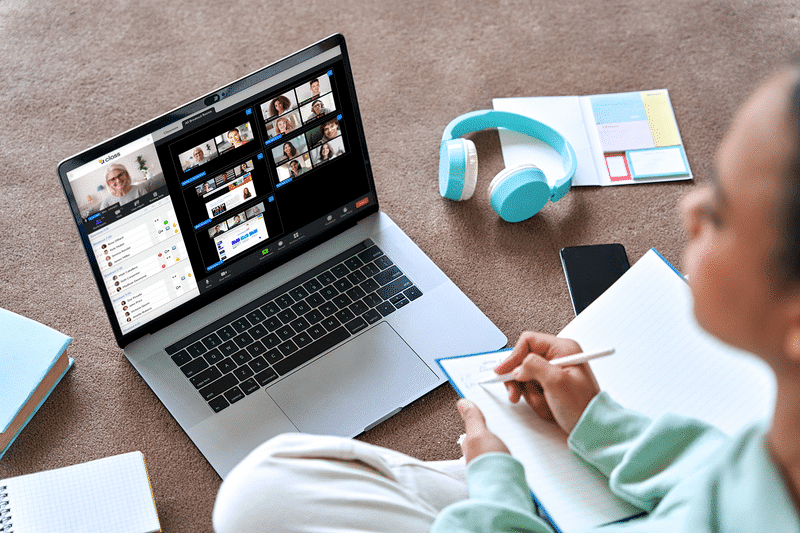


More than two years ago, educators and students at all levels of education were suddenly thrust into a forced experiment with remote and hybrid instruction. For many, the experiment worked well and resulted in positive outcomes for both students and teachers.
At the higher-ed level, one of the significant benefits for students has been the flexibility afforded them to address school and personal needs, including caring for a family, working, or pursuing other avocational interests.
An article in government technology reports that: “Universities are looking to expand courses hosting asynchronous and synchronous lectures both online and in-person to meet student demands for flexible schedules in a post-pandemic landscape.
Like The Chronicle of Higher Education, other outlets have reported that “some colleges are ending hybrid learning.” However, they’re also saying that students are pushing back.
After several months engaged in new ways of learning and interacting with professors, other speakers, and guests, students have discovered that they like this newfound flexibility—at least some of the time.
We recently spoke with leaders at Stanford Graduate School of Business and the Harvard Division of Continuing Education about their experiences during the pandemic and how they believe educational delivery will go.
Audrey Witters is managing director of online executive education for Standard Business Graduate School of Executive Education; Adrienne Phelps-Coco, Ph.D., is executive director of teaching and learning for the Harvard Division of Continuing Education. Their institutions embrace new ways of engaging students in a hybrid environment.
However, they acknowledge that the terminology around remote or hybrid learning can be confusing, with many of the terms being used differently by different schools.
As Phelps-Coco says: “The terms are quite complicated.” But, she says, she views virtual as “something that happens in the online space.” Moreover, this “something” could be either asynchronous or synchronous—or both.
The bottom line, though, as Danette Howard, senior vice president and Chief Policy Officer, at Lumina Foundation, points out, is that: “Hybrid learning at the college level allows students the flexibility to manage work and studies.”
It’s an option that educators are finding is vastly preferred by many.
Surveys by Cengage and EDUCAUSE indicate that:
While hybrid learning was already occurring pre-pandemic, adoption had been relatively flat. During the pandemic, though, instructors, students, and IT professionals have identified new opportunities and innovations in hybrid learning, making this option more preferred than ever.
As Witters notes, Standard had already experimented with blended learning pre-pandemic, but there was “a lot more experimentation during the pandemic.” And, she says, these experiences have led to high demand for a wide range of instruction variations.
Harvard, for instance, is offering a Hybrid-Flexible, or HyFlex model. It’s a model that allows students to move between in-person and online participation in classes on a week to week or even class to class basis, depending on their preferences. For instructors, HyFlex means they must offer online and in-person versions of their classes. It’s an option that they first began exploring in 2015.
For adult learners, Phelps-Coco says, “it has been really critical for flexibility and putting decisions into the hands of the students.”

Instructors have also learned over the past several months that being innovative and incorporating fun elements into online or hybrid learning experiences is vital to engage students—and keep them engaged.
Doing this effectively requires staff to be trained in the technology used to deliver courses, but technology isn’t the most critical factor here, say both Witters and Phelps-Coco.
As Witters says, “the expectations that faculty have are very similar to learners—coming into a hybrid environment hoping to replicate the energy and interaction of an in-person format.” Over the past two years, she says one of the significant benefits has been discovering what can be done in a virtual format.
Phelps-Coco agrees and notes that one area of focus has been the ability to deliver lab experiences in a virtual or hybrid manner—combining virtual instruction with in-person labs and vice versa by shipping lab kits to students at their homes.
Harvard has created teaching studios—like professional television studios—to elevate the experience of receiving instruction online, offering flexibility for instructors to engage with students in and outside of the classroom and offering a variety of experiences for students to help keep them engaged.
In addition to recognizing that learning should be fun to some degree, it’s also essential to consider the type of material being covered and how to match the appropriate modalities to learning outcomes, says Witters. She points to three types of learning that each requires a different approach:
“One of the things that can be so powerful with the online experience is that activities don’t have to be done online—they can be done in your workplace or your neighborhood,” says Phelps-Coco.
What the pandemic has done, and what faculty and students have gained, is discovering what works well, what doesn’t, and how to best combine various elements of the online and offline world, synchronous and asynchronous learning, to offer the best combination of activities to achieve learning outcomes.
While, initially, faculty may not have received as much training and support as they would have liked, they’ve learned to speak up to ask for the training and help they need. Now, institutions have identified opportunities to provide that support, much like students are being taught through in-person and online activities.
With her programming, it’s been important, says Witters, to have ongoing conversations with faculty and staff, learners, clients, and program sponsors. The support of any hybrid initiative needs to have a wide range of people at the table to get input from those delivering the training and those receiving and supporting the training. “We all need to listen to each other and collaborate,” she says.
“Training is not just about technology, but about communication and collaboration,” Phelps-Coco adds. It’s about taking the time to seek input from students with intention. That might mean during class, or it might mean having online “office hours”—or after class chats that continue after the formal class has ended.
It’s about asking people: How is this going for you? Are you learning? Do you have the experience you want to have? Then, listen to those inputs you gather.
The pandemic teaching and learning experience has provided ample opportunity for innovation in hybrid learning. That innovation will only continue and become richer and more relevant as these conversations continue. The lessons learned will offer insights into what works and doesn’t and continue to experiment with new ways of engaging and enlightening students.
To hear the full conversation, watch the recording of Innovations in Hybrid Learning: Engage Students and Promote Institutional Success.


Get our insights, tips, and best practices delivered to your inbox

Sign up for a product demo today to learn how Class’s virtual classroom powers digital transformation at your organization.

Features
Products
Integrations